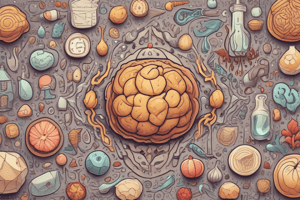Podcast
Questions and Answers
What is the function of hyaluronic acid in joint cavities?
What is the function of hyaluronic acid in joint cavities?
- To stimulate immune response
- To act as a lubricant (correct)
- To regulate blood clotting
- To provide structural support
What is the characteristic feature of keratan sulfate?
What is the characteristic feature of keratan sulfate?
- It does not contain any uronic acid (correct)
- It has a negatively charged carbohydrate chain
- It contains uronic acid
- It has a long carbohydrate chain
In which tissue is chondroitin sulfate widely distributed?
In which tissue is chondroitin sulfate widely distributed?
- Muscle
- Skin
- Bone
- Cartilage (correct)
What is the primary use of heparin in medicine?
What is the primary use of heparin in medicine?
What is the difference between GAGs and glycoproteins?
What is the difference between GAGs and glycoproteins?
Where is dermatan sulfate primarily found?
Where is dermatan sulfate primarily found?
What is the characteristic feature of glycoprotein carbohydrate chains?
What is the characteristic feature of glycoprotein carbohydrate chains?
What is the term for the group of lysosomal storage disorders characterized by abnormal mucopolysaccharide excretion in urine?
What is the term for the group of lysosomal storage disorders characterized by abnormal mucopolysaccharide excretion in urine?
What is the primary function of glycosaminoglycans in the body?
What is the primary function of glycosaminoglycans in the body?
What is the main difference between glycosaminoglycans and glycoproteins?
What is the main difference between glycosaminoglycans and glycoproteins?
What is the term for polysaccharides containing more than one type of sugar residues?
What is the term for polysaccharides containing more than one type of sugar residues?
What is the role of the core protein in glycosaminoglycans?
What is the role of the core protein in glycosaminoglycans?
What are the components that are generally present in glycosaminoglycans?
What are the components that are generally present in glycosaminoglycans?
What is the term for glycosaminoglycans that are associated with a small amount of protein?
What is the term for glycosaminoglycans that are associated with a small amount of protein?
What is the main characteristic of glycosaminoglycans that allows them to form the gel-like matrix?
What is the main characteristic of glycosaminoglycans that allows them to form the gel-like matrix?
What is the term for glycoproteins that consist of protein with a small amount of carbohydrate?
What is the term for glycoproteins that consist of protein with a small amount of carbohydrate?
Study Notes
Carbohydrates Lecture Notes
Heteroglycans
- Heteroglycans are polysaccharides containing more than one type of sugar residues.
- Examples include mucopolysaccharides (glycosaminoglycans).
Glycosaminoglycans (GAGs)
- GAGs are large complexes of heteropolysaccharide chains associated with a small amount of protein (core protein).
- They consist of up to 95% carbohydrate.
- GAGs have the ability to bind large amounts of water, forming a gel-like matrix in the body's ground substance.
- They are found in connective tissues and are associated with fibrous structural proteins.
- GAGs may contain uronic acid, amino sugars, acetylated amino groups, sulfate, and carboxyl groups.
Specific Glycosaminoglycans
- Hyaluronic Acid: found in connective tissues, tendons, synovial fluid, and vitreous humor; serves as a lubricant in joint cavities; composed of repeating units of Glucuronic acid → β 1-3-N-Acetyl glucosamine.
- Chondroitin Sulfate: found in ground substance of connective tissues, cartilage, bone, tendons, cornea, and skin; composed of repeating units of Glucuronic acid → β 1,3-N-acetyl galactosamine sulfate.
- Heparin: an anticoagulant used in vitro and in vivo; contains repeating units of sulphated glucosamine → alpha-1, 4-sulphated iduronic acid.
- Keratan Sulfate: found in cornea and tendons; does not contain uronic acid; composed of repeating units of sulfated galactose and N-acetyl glucosamine in beta linkage.
- Dermatan Sulfate: found in skin, blood vessels, and heart valves; composed of repeating units of L-iduronic acid and N-acetyl galactosamine in beta-1, 3 linkages.
Glycoproteins
- Glycoproteins are proteins with covalently attached oligosaccharides.
- The carbohydrate chain in glycoproteins is relatively short (usually 2 to 10 sugar residues in length).
- Glycoproteins do not have repeating disaccharide units like GAGs.
- Glycoprotein carbohydrate chains are often branched instead of linear.
- Glycoproteins may or may not be negatively charged.
Studying That Suits You
Use AI to generate personalized quizzes and flashcards to suit your learning preferences.
Description
This lecture covers the topic of carbohydrates in Clinical Biochemistry, led by Dr. Naeem Salih Alzaidi. It's a part of the MCBM and Clinical Biochemistry course.



